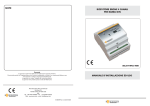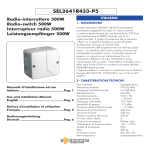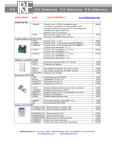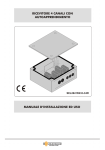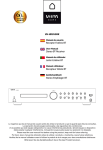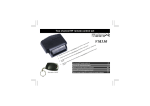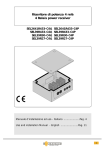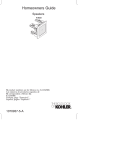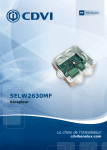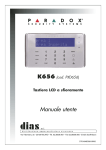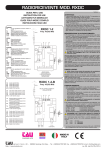Download Radioprogrammatore 750W Plus
Transcript
Radioprogrammatore 750W Plus Radioprogrammer 750W Plus Récepteur séquentiel 750W Plus Funkmotorsteuerung 750W Plus SEL2641R433-P7P , SEL2641F433-P7P Manuale d’installazione ed uso - Italiano ............Pag. 4 Use and installation Manual - English .................Pag. 7 Notices d’installation et utilisation - Français .....Pag. 10 Bedienungsanleitung - Deutsch ...........................Pag. 13 THE SMART LIVING ? Misure di sicurezza Per un perfetto funzionamento dell’apparecchio, si prega di leggere interamente questo manuale e seguire attentamente le indicazioni ivi descritte, in quanto l’uso improprio può danneggiare l’apparecchio Dichiarazione di Conformità: Il costruttore Elpro Innotek Spa dichiara che i radioprogrammatori mod. SEL2641R433-P7P, SEL2641F433-P7P, sono conformi alle Direttive Europee 73/23/CEE, 89/336/CEE e 99/05/CE. Security measures For a perfect functioning of the device, read carefully this manual and follow all the indications, since an inadeguate use can make damages to the device Declaration of Conformity: Elpro Innotek Spa as manufacturer declares that the following appliances : SEL2641R433-P7P, SEL2641F433-P7P, fullfil the requirements of the European Directives 73/23/CEE, 89/336/CEE and 99/05/CE. Mesures de sécurité Pour un fonctionnement parfait de l’appareil, vous devez lire complétement les instructions de installation et suivre estrictement les indications décrites, puisque un maniement inadéquat peut produire dommage à l’appareil. Sicherheitsmaßnahmen Um ein einwanfreies Functionieren des Apparates zu erhalten, sollten Sie die in der Bedienungsanleitung enthaltene Anweisungen zur Bedienung und zur Installation genau durchlesen und befolgen, da eine Nichtbeachtung derselben starke Schäden am Apparat hervorrufen kann. ? Déclaration de Conformité: Elpro Innotek Spa déclare que les appareils SEL2641R433P7P, SEL2641F433-P7P, sont conformes aux exigences essentielles et autres dispositions des Directives 73/23/CEE, 89/336/CEE e 99/05/CE. Declaration of Conformity: Der Funkmotorsteuerung ( typ SEL2641R433-P7P, SEL2641F433-P7P,) entspricht den europäischen Normen 89/336/CEE 73/23/CEE, 99/05/CE, EG Konformitätsbescheinigung. Presentazione / Introduction / Introduction / Allgemein 4 viti per fissaggio del coperchio 4 screws for cover fixing 4 vis capot 4 Schraube Coperchio Cover Couvercle Deckel 4 Viti per fissaggio della scatola 4 screws for box fixing 4 vis de fixation Schraube Passacavi Wire leads Passes-fils Kabelführung 4 tasselli 4 plugs 4 chevilles 4 Einsatz Scatola con ricevitore e coperchio di protezione in plexiglass Receiver box with plexiglas cover Boîtier avec récepteur et plexiglas de protection Behälter mit Funkmotorsteuerung Antenna Aerial Fil d’antenne Antenne Fig. 1 Pag. 2 Dimensioni d’ingombro / Overall dimensions Dimensions Interassi / Drilling distances Distances de perçage / Spurweiten 52 104 140 115 Fig. 2 128 Fig. 3 Layout Tasto PR - LED LR Push-button PR - LED LR Touche PR - LED LR Taster PR - LED LR Tasto PV - LED LV Push-button PV - LED LV Touche PV - LED LV Taster PV - LED LV Trasformatore di alimentazione Transformer Transformateur Trasformator PV PR LV LR Dip-switch 6 vie Dip-switch Dip-switch Dip-switch zur programmierung 1 2 34 5 6 ON TEMPORIZZAZIONE OFF 1 2 3 4 5 Fusibile F2 : 6A - 250V Fuse F2 : 6A - 250V Fusible F2 : 6A - 250V Sicherung F2 : 6A - 250V ON ON ON ON ON 6 sec 12 sec 24 sec 46 sec 92 sec ON 123456 F2 Fusibile F1 : 315mA - 250V Fuse F1 : 315mA - 250V Fusible F1 : 315mA - 250V Sicherung F1 : 315mA - 250V = = = = = L2 Led L1 : Contatto NC sicurezze Led L1 : NC safety contact Led L1 : Contact NC securitè Led L1 : F1 C P 1 N 2 3M 4 5 6 230F V N C OUV/FERM A CH 7 24 VAC 8 9 10 11 12 13 14 15 24 V Morsettiere di I/O Terminal boards Bornes Anschlüsse ON ON ON ON ON Buzzer Sonner 6 ON sequenziale 6 ON seq + uomo pres. 6 OFF uomo presente L1 S1 S2 S3 S4 S5 modo di funzionamento 6 sec. 12 sec. 24 sec. 46 sec. 96 sec. Led L2 : Contatto NA esterno Led L2 : NO external command Led L2 : Contact NO exterieur Led L2 : Sicherheitsvorrichtung S6 ON = Sequenziale / Sequential mode / sequentiel / sequenziell S1, S2, .., S5 ON / S6 OFF : Misto / Mixed / Mixte / gemischter Betrieb S1, S2, .., S6 OFF = Uomo Presente / Man present / homme mort / Fig. 4 Pag. 3 3 - FUNZIONALITA' ITALIANO Sequenziale (o ciclico): 1 Impulso apre Il ricevitore sequenziale ERONE 750 W Plus è un 1 Impulso chiude, ferma a tempo o ad impulso. radioprogrammatore in grado di pilotare direttamente un motore Misto: asincrono da 750W max equipaggiato di condensatore di spunto. 1 impulso apre, La frequenza di ricezione e la modulazione variano a seconda del chiusura a uomo presente. modello. La seguente tabella riassume i sequenziali della gamma Uomo presente: Erone evidenziandone serie, modello, frequenza e modulazione: apertura e chiusura a contatto permanente (portata ridotta). 1 - DESCRIZIONE SERIE ERONE433 ERONE433 MODELLO FREQ. CODIFICA MOD. SEL 2641R433P7P 433.92 MHz SEL 2641F433P7P 433.92 MHz Rolling code AM Rolling code FM A seconda della modulazione , il ricevitore funziona con differenti modelli di trasmettitori ERONE, secondo la tabella seguente: Modello Sequenziale Trasmettitori impiegabili SEL 2641 R433P7P S2TR2641E2/E4 SETR2641AM2 SETR2641-TM SEL 2641 F433P7P S2TR2641F2/E4 SETRF641FM2 Il tempo di lavoro del motore (da 6 a 186 sec) è selezionabile attraverso 5dip-switches; esso serve anche da sicurezza in caso di blocco motore, per evitare che questo rimanga sotto tensione. Possibilità di lavorare in comando locale o in comando generale per gruppi di serrande; il comando generale è possibile solo per il funzionamento sequenziale). Per il comando generale è necessario possedere un trasmettitore a 4 canali della stessa gamma. È possibile collegare un pulsante esterno o un contatto a chiave come completamento al radiocomando. Capacità di memoria del ricevitore è di 85 trasmettitori. 4 - INSTALLAZIONE Posizionamento 2 - CARATTERISTICHE TECNICHE Modelli Tipo ricevitore Frequenza portante Frequenza oscillatore locale Modulazione Impedenza d'ingresso Frequenza intermedia Sensibilità d'ingresso Emissione dell'oscillatore locale Tensione di alimentazione Potenza massima del motore Uscita ausiliaria Capacità di memoria Temperatura di funzionamento Grado di protezione Peso Dimensioni Modelli Tipo ricevitore Frequenza portante Frequenza oscillatore locale Modulazione Impedenza d'ingresso Frequenza intermedia Sensibilità d'ingresso Emissione dell'oscillatore locale Tensione di alimentazione Potenza massima del motore Uscita ausiliaria Capacità di memoria Temperatura di funzionamento Grado di protezione Peso Dimensioni Pag. 4 SEL2641R433-P7P Supereterodina 433.92 MHz 6,6128 MHz AM/ASK 50 Ohm 10,7 MHz -115 dBm < -57 dBm 230 Vac 750 W 24 Vac / 200 mA 85 -20°÷+70°C IP44 380 gr. 140 x 115 x 52 mm La scelta della posizione del ricevitore è molto importante per ottenere un buon funzionamento del sistema. Devono essere rispettate le seguenti condizioni: - posizionare il ricevitore lontano da fonti di disturbo quali sistemi informatici, allarmi o altre emissioni radio. - la distanza tra due ricevitori deve essere superiore a 1.5 metri. Fissaggio Togliere il coperchio dal ricevitore. Fissare la scatola ad ogni angolo utilizzando viti e fisher in dotazione o con viti appropriate alla natura del supporto. Connessioni 1- Collegare l'alimentazione ai morsetti corrispondenti (fig. 5): morsetto 1 = PH fase morsetto 2 = N neutro morsetto 6 = terra SEL2641F433-P7P Supereterodina 433.92 MHz 6,6128 MHz FM/FSK 50 Ohm 10,7 MHz -111 dBm < -57 dBm 230 Vac 750 W 24 Vac / 200 mA 85 -20°÷+70°C IP44 380 gr. 140 x 115 x 52 mm Fig. 5 1 2 Ph N 6 2 - Collegare il motore ai morsetti corrispondenti (fig. 6): morsetto 3 = C comune morsetto 4 = O apertura morsetto 5 = F chiusura morsetto 7 = terra collegare il condensatore di rifasamento tra i morsetti 4 e 5. Fig. 6 3 C 4 5 O F 7 3 -Collegare gli accessori come segue (fig. 7): - se collegate un'antenna (non in dotazione), collegare la calza al morsetto 15, ed il centrale al morsetto 14; oppure collegare il filo d'antenna in dotazione al morsetto 14. - se collegate un dispositivo di comando, ad es. un pulsante esterno (non in dotazione), collegare il contatto n.a. tra i morsetti 12 e 13, mentre un dispositivo di sicurezza ad es. fotocellula, con contatto n.c. tra i morsetti 10 e 11; Scelta del tempo di lavoro nel modo di funzionamento sequenziale o misto Gli switches 1 a 5 posizionati su ON, in funzionamento sequenziale o misto, permettono di selezionare il tempo di lavoro del motore (lo scadere del tempo di lavoro provoca l'arresto). Switch 1 = Switch 2 = Switch 3 = Switch 4 = Switch 5 = 6 secondi 12 secondi 24 secondi 48 secondi 96 secondi NOTA1:I morsetti 10 -11 se non utilizzati, vanno ponticellati. Se il contatto N.C non è chiuso il led L1 rimane spento. Quando attivato, il contatto NC provoca il blocco del movimento Più switches posizionati in ON sommano il tempo di lavoro. del motore sia in Apertura sia in Chiusura. NOTA2:Il led L2 si accende quando viene attivato il contatto N.A. Scelta del tipo di comando del comando esterno. ! Comando locale L1 L2 Fig. 7 ! Comando generale E' necessario disporre di un trasmettitore a 4 canali della stessa gamma. 8 9 10 11 12 13 14 15 24 Vac Togliere tensione prima di sollevare il plexiglas di protezione e prima di intervenire sulla morsettiera ! I trasmettitori memorizzati su PR permettono di lavorare in modo sequenziale misto o a uomo presente e necessitano di un solo pulsante del trasmettitore per aprire, chiudere e fermare. Il comando locale è prioritario sul comando generale. Il morsetti 8-9 prevedono una uscita 24 Vac / 200 mA per carichi esterni ( ad es. fotocellule, od altro). 5 - PROGRAMMAZIONE Il modo di funzionamento del radioprogrammatore si imposta facendo uso del dip-switch a 6 vie presente sulla scheda elettronica ( Fig. 8.) I trasmettitori memorizzati su PV permettono di lavorare in modo sequenziale, ma necessitano di tre pulsanti del trasmettitore, un pulsante (B) per aprire, un pulsante (D) per chiudere, e un pulsante (C) per l'arresto. Durante il moto (apertura o chiusura) soltanto il pulsante di arresto (C) rimane attivo. Per ottenere l'inversione del moto senza passare per il pulsante di arresto (C), è necessario attendere la fine del tempo di lavoro. ! Per essere sicuri di comandare tutti i ricevitori contemporaneamente, è consigliabile utilizzare il radiocomando ad una distanza minima ( non superare i 20 metri ) 6 - MEMORIZZAZIONE DEI TRASMETTITORI PV PR LV LR 1 2 34 56 ON OFF Fig. 8 ON 123456 Scelta del modo di funzionamento NOTA: Il tempo di emissione prolungato causa l'usura più rapida della batteria del radiocomando. Funzionamento B - Memorizzazione diretta in comando generale PV ON secondo il tempo desiderato OFF A UOMO PRESENTE A - Memorizzazione diretta in comando locale PR 1) Premere e tener premuto il pulsante PR : il led LR si accende; 2) Rilasciare il tasto PR ; 3) Premere il tasto del trasmettitore che si intende memorizzare : il led LR si spegne ; 4) Ripetere poi l’operazione per ogni tasto del trasmettitore. Dip-switch 1-5 Dip-switch 6 E' necessario disporre di un trasmettitore a 4 canali della stessa SEQUENZIALE secondo il tempo desiderato ( CICLICO ) MISTO Il codice di ogni singolo tasto può essere memorizzato nel radioprogrammatore in 2 modi diversi: A / B - Direttamente sul radioprogrammatore mediante pressione del tasto PR o PV; C / D - Per autoapprendimento a distanza, mediante i tasti del radiocomando. OFF OFF gamma Premere e tener premuto il pulsante PV del ricevitore fino all'accensione del led verde LV; Entro 4 secondi premere il tasto D del radiocomando da memorizzare. Il led LV si spegne ed il relè del motore si eccita per un attimo. Il tasto D provocherà la chiusura del motore. La memorizzazione dei rimanenti tasti del radiocomando avviene automaticamente associando al tasto B l'apertura ed al tasto C l'arresto. Pag. 5 C - Memorizzazione per autoapprendimento comando locale PR 1) Premere contemporaneamente i tasti A e B del Tx : i led LR ed LV si accendono per un attimo ed il buzzer emette un bip; 2) Premere il tasto A dello stesso TX per 4 sec.: il led LR si accende ed il buzzer emette un bip continuo=Biiiiiiip; 3) Premere entro 2 sec. il tasto del Tx da memorizzare: il led LR si spegne. D - Memorizzazione per autoapprendimento comando generale PV 1) Premere contemporaneamente i tasti A e B del Tx :i led LR ed LV si accendono per un attimo ed il buzzer emette un bip; 2) Premere il tasto B dello stesso TX per 4 sec.: il led LV lampeggia ed il buzzer emette un bip intermittente= Bip, Bip, ..,Bip; 3) Premere entro 2 sec. il tasto D del Tx da memorizzare: il led LV si spegne ed il relè del motore si eccita per un istante. NOTA 1 : La memorizzazione dei rimanenti tasti del radiocomando avviene automaticamente associando al tasto B l'apertura ed al tasto C l'arresto. Verifica del numero dei trasmettitori memorizzati Sul ricevitore, entrare in modo programmazione premendo PR finchè LR si accende. Rilasciare PR e ripremere PR per un secondo. A partire da questo momento, i led lampeggiano formando la sequenza a 7 bit di cui al numero precedente. Il totale ricavato con la tabella di corrispondenza indica la quantità di trasmettitori memorizzati. Verifica della posizione trasmettitore in memoria di un codice Premere sul pulsante del radiocomando che si desidera controllare e rilasciare. Di seguito premere il pulsante PR del ricevitore per almeno un secondo. A partire da questo istante i led lampeggiano formando una sequenza di 7 bit, così come descritto precedentemente. In base ad essa è possibile risalire alla posizione di memoria del Sostituzione di un codice in memoria E' possibile cancellare un codice trasmettitore dalla memoria, memorizzandone un altro nella stessa posizione. Per far ciò è necessario conoscere la posizione di memoria del trasmettitore da sostituire. 7 - CANCELLAZIONE Questa operazione può essere fatta seguendo le indicazioni Cancellazione dei trasmettitori dalla memoria riportate nel paragrafo precedente "Verifica della posizione di un Premere PR fino a quando il led rosso si accende, rilasciare PR poi, di codice trasmettitore in memoria". seguito premere PR e PV contemporaneamente fino a quando i due Una volta nota la posizione di memoria da sostituire, procedere nel modo seguente: led lampeggiano per 3 volte. - Sul ricevitore, premere PR fino a quando il led corrispondente si In questo modo tutti i codici vengono cancellati dalla memoria. accende; rilasciare PR. - Premere PV per almeno un secondo; 8 - GESTIONE CONDOMINIALE -Comporre di seguito, entro 2 secondi, la sequenza binaria di 7 bit premendo PR e PV, relativa alla posizione di memoria da sostituire. Per utilizzare la gestione dei codici, è necessario prendere nota in Esempio di posizionamento sulla 42 esima cella di memoria: quale cella di memoria il codice di ciascun trasmettitore è memorizzato ed a quale relè è associato. La gestione dei codici è LR LV LR LV LR LV LR utile nel caso di memorizzazioni di molti trasmettitori nel ricevitore, in una installazione condominiale (es.: 85 trasmettitori memorizzabili 0 2 0 8 0 32 0 nelle celle da 1 a 85). 0 + 2 + 0 + 8 +0 + 32 +0 = 42 La posizione della memoria è indicata attraverso una sequenza binaria a 7 bit. Per prendere nota della posizione bisogna riferirsi alla Premere in perciò sequenza: tavola di corrispondenza seguente osservando la posizione nella PR, PV, PR, PV, PR, PV, PR. sequenza del led verde LV: A partire da questo momento il led rosso LR si accende a conferma dell'ingresso in modo programmazione. Premere entro 4 secondi il pulsante ( A, B, C o D ) del trasmettitore da memorizzare. corrispondenza 1 2 4 8 16 32 64 Il led rosso LR si spegne confermando l'avvenuta sostituzione. Bisogna tenere conto soltanto delle accensioni del led verde, In questo modo il vecchio codice viene cancellato e il ricevitore risponde al nuovo codice memorizzato. essendo il led rosso uguale allo zero. codice 7 bit 1 2 3 4 5 6 7 LV ESEMPIO : Lettura dei led per la posizione 37 della memoria: 1a 2a 3a 4a 5a 6a 7a accensione: accensione: accensione: accensione: accensione: accensione: accensione: led verde led rosso led verde led rosso led rosso led verde led rosso 1 2 3 4 5 1 2 4 8 16 32 64 Memoria piena Quando la memoria è piena, cioè quando le 85 o 100 celle di memoria ( in relazione al modello utilizzato ) sono occupate, i led rosso LR e verde LV lampeggiano 3 volte contemporaneamente quando si entra in programmazione; il led corrispondente al led sollecitato resta quindi acceso per 4 secondi (modo di programmazione) al fine di permettere l'eventuale cancellazione di un trasmettitore già memorizzato (vedi paragrafo precedente). 6 7 1 + 0 + 4 + 0 + 0 + 32 + 0 = 37 - è possibile utilizzare sempre lo stesso trasmettitore (es.: il trasmettitore utilizzato per la manutenzione dell'impianto, per cancellare i codici utenti). Pag. 6 3 - FUNCTIONALITY ENGLISH 1 - INTRODUCTION The receiver ERONE 750 W Plus is a radio programmer which can drive directly an asynchronous 230 Vac AC motor with max power of 750 W. The operating frequency and the coding system are different, depending upon the model. The following table summarises the range of Erone radio programmers, pointing out series, frequency and coding system: SERIES ERONE433 ERONE433 MODEL FREQ. CODING SEL 2641R433P7P 433.92 MHz SEL 2641F433P7P 433.92 MHz MOD. Rolling code AM Rolling code FM Depending upon the modulation, the receiver operates with different transmitters ERONE, according to the following table: Receiver Type Usable transmitter SEL 2641 R433P7P S2TR2641E2/E4 SETR2641AM2 SETR2641-TM SEL 2641 F433P7P S2TR2641F2/F4 SETR2641FM 2 - TECHNICAL SPECIFICATIONS Type Receiver type Carrier frequency Local oscillator frequency Modulation Input load Intermediate frequency Input sensitivity Local oscillator emissions Power voltage Motor maximum power Auxiliary output Memory capacity Operating temperature IP grade Weight Overall dimensions Type Receiver type Carrier frequency Local oscillator frequency Modulation Input load Intermediate frequency Input sensitivity Local oscillator emissions Power voltage Motor maximum power Auxiliary output Memory capacity Operating temperature IP grade Weight Overall dimensions SEL 2641R433-P7P Superheterodyne 433,92 MHz 6,6128 MHz AM/ASK 50 Ohm 10,7 MHz -115 dBm < -57 dBm 230 Vac 750 W 24 Vac / 200 mA 85 -20°÷+70°C IP44 380 gr. 140 x 115 x 52 mm SEL 2641F433-P7P Superheterodyne 433,92 MHz 6,6128 MHz FM/FSK 50 Ohm 10,7 MHz -111 dBm < -57 dBm 230 Vac 750 W 24 Vac / 200 mA 85 -20°÷+70°C IP44 380 gr. 140 x 115 x 52 mm Sequential (or cyclic): 1 Pulse opens 1 Pulse closes, stop with a timer Mixed 1 Pulse opens, closing only with permanent contact. Man present: Opening and closing only with permanent contact (reduced range). The motor time-out is selectable (from 6 to 186 sec) by means of 5 dip - switches; it is used as security to avoid powering the motor for too long after the mechanical stop. Other features: Local and general operating selection (with multiple motor driving); the general command is possible only for the sequential operating mode. For the general mode using it is necessary to use a 4 keys transmitter of the same range. It possible to connect an external push button or a key - contact to complete the radiocontrol. The memory capacity is 85 or 100 transmitters. 4 - INSTALLATION Positioning The local choice is very impotant for the best result of the installation. The following conditions have to be followed: - Fix the radioprogrammer far from the interference sources as informatic systems, alarm systems or other radio emissions. - The distance between 2 receivers should be greater of 1.5 mt. Fixing Remove the cover of the receiver; fix the box in each corner by using the screws and the plugs supplied. Connections 1- Connect the power supply (230 Vac) to the terminal blocks (fig. 10): terminal 1 = PH phase terminal 2 = N neutral terminal 6 = earth Fig.10 1 2 Ph N 6 2 - Connect the motor to the terminal blocks (fig. 11): terminal 3 = C common terminal 4 = O open terminal 5 = CL close terminal 7 = GND ground Connect the capacitor between terminals 4 and 5. Fig. 11 3 C 4 5 O CL 7 Pag. 7 3 -Connect the accessories as follows (fig. 12): Operating time selection during the sequential and mixed mode - if you want to use an antenna,( not supplied), connect the shield to the terminal 15 and the net to the terminal 14, otherwise if you use the antenna cable supplied, connect it to the terminal 14. - if you want to connect an external command device (not supplied), connect the N.O. contact to the terminals 12 and 13. - a safety device ( as photocells, with n.c. contact) has to be connected between terminals 10 and 11; By positioning the dip-switches 1 to 5 on ON, during the operating modes sequential and mixed, it is possible to select the time-out of the motor. Switch 1 = 6 seconds Switch 2 = 12 seconds Switch 3 = 24 seconds Switch 4 = 48 seconds NOTE1:If the terminals 10-11 are left unconnected, they have to be Switch 5 = 96 seconds shorted. If the N.C. contact is not closed, the led L1 remains off. Multiple switches positioned on ON position causes the sum of the When this contact is activated, it causes the blockage of the motion resulting time. both in opening and in closing. Command type setting NOTE2:The led L2 switches on when the N.O. contact of the external command is activated. L1 L2 Fig. 12 8 9 10 11 12 13 14 15 24 Vac ! Remove the power before to pick - up the protection plexiglass and operate on the terminal blocks. The terminals 8-9 are an output of 24 Vac / 200 mA for external loads ( ex. photocells, etc.). 5 - PROGRAMMING The operating mode of the radio-programmer is selected with the 6-ways binary dip-switch ( Fig. 13.) PV PR LV LR 1 2 34 56 ON OFF Fig. 13 ON 123456 ! Local command The transmitter strored on PR allow to operate in sequential, mixed or man present mode and by pushing only one key of the transmitter for all the movements (opening, stop and closing). ! General command It is necessary to have a 4 keys transmitter of the same series The transmitters stored on PV allow to operate in sequential mode but need 3 keys, a key (B) to open a key (D) to close and a key (C) to stop. During the movement (opening or closing) only the stop key (C) is enabled ! In order to be sure of the complete drive of all the receivers, it is advisable to use the transmitter at the minimum distance (do not use over 20m) 6 - TRANSMITTER CODES MEMORISATION The transmitter key code can be stored onto the radioprogrammer in 2 ways: A / B - Using the radioprogrammer push-buttons PR and PV C / D - In self-learning mode, far from the appliance, using the transmitter keys. A - Local command using PR 1) Push and keep pushed the button PR of the receiver until the led LR switches on; 2) Within 4 seconds push the key of the transmitter to memorise. The red led LR will switch off. 3) Repeat the same procedure for each transmitter key. B - General command using PV It is necessary to have a 4 key transmitter of the same range Operating mode selection WARNING: The use of the Man present mode causes a faster consumption of the transmitter battery. Operating mode Dip-switch 1-5 Dip-switch 6 SEQUENTIAL ( CYCLIC ) According selected time ON MIXED According selected time OFF MAN PRESENT OFF OFF Pag. 8 1) Push and keep pushed the button PV of the receiver until the green led LV switches on; 2) Within 4 seconds push the key D of the transmitter to memorise. 3) The green led LV will switches off and the motor relay will activate for a while. The D key will make the closing of the motor. The activation of the remaining transmitter keys is automatic, by correlating the key B to the opening and the key C to the stop. C - Local command using the keys of the transmitter 1) Push and keep pushed simultaneously the keys A and B of the TX : LR and LV will flash and the buzzer makes a bip. 2) Push the key A of the same TX for 4 sec. until the led LV switches on and the buzzer emits a long bip =Biiiiiiip, then release the key. 3) Before the end of the bip ( about within 2 sec.) push again the key A of the TX : LR will switch off. Check of the number of stored transmitters On the receiver, enter in programming mode by pushing PR until LR switches ON. Release PR and push againg PR for one second. 1) Push and keep pushed simultaneously the keys A and B of the TX : From now on, a sequence of led flashes commences, showing a number which can be calculated by following the previous table. LR and LV will flash and the buzzer makes a bip. 2) Push the key B of the same TX for 4 sec. until the led LV start to blink The final number is equal to the total number of codes stored in the memory. and the buzzer makes bip, bip, bip,..,bip. then release the key. 3) Before the end of the bip ( about within 2 sec.) push the key D of the Check of the transmitter position inside the TX : LV will switch off. D - General command using the keys of the transmitter memory. NOTE 1 : The memorization of the remaining transmitter key is Push and release the transmitter button for which it is necessary the check. Push PR for 1 second: from this time on, a led flash sequence starts. By decoding the message, as explained above, it is possible to get the 7 - MEMORY ERASURE Push PR and keep it pressed down until the led LR switches on. Replacement of the code of a stored transmitter Then push simultaneously PR and PV until both the leds LR and LV start to blink. It is possible to delete a stored transmitter code and replace it with in this way all the codes present in the memory will be erased. another one, in the same memory position. For this operation it is necessary to know exactly the memory position of the transmitter to replace. 8 - CONDOMINIUM MANAGING See the previous chapter titled "Check of the transmitter position For the managing of the codes it is previously neccary to annotate the inside the memory". memory locations of each transmitter code and to wich relay it is Once known the memory position of the transmitter which has to be replaced, follow the next procedure: correlated. The transmitter codes management is usefull when it is necessary to store many codes into the receiver, for a condominium installation - On the receiver push and keep pushed PR until the led LR is ON. Push PV for at least 1 second. (ex. 100 transmitters into 100 memory locations). - Start the binary sequence by pushing PR or PV in order to get the position of the memory cell to replace. Operating description The position of the code in the memory is displayed by a binary Example of a new transmitter positioning on the 42th cell of memory: sequence of 7 bit. In order to calculate the right position of the code refer to the following table: by making attention to the flash sequence of the LR LV LR LV LR LV LR green led LV: 0 2 0 8 0 32 0 0 + 2 + 0 + 8 +0 + 32 +0 = 42 7 bit code 1 2 3 4 5 6 7 LV association 1 2 4 8 16 32 64 Push in sequence: PR, PV, PR, PV, PR, PV, PR. Fom now on the red led LR lights on showing the start of the It is enough to take into count only the flashes of the green programmation phase. led because the value of the ones of red led have always Store the new transmitter code by pushing on the desired transmitter value 0. button (A, B, C or D). At the end the red led turn off, by giving the acknowledge of the EXAMPLE : Led sequence correspondent to the 37th successful procedure. In this way the old code has been deleted and the new one has been positions of the memory: stored in the same memory position and will activate the relay. 1st flash: 2nd flash: 3rd flash: 4th flash: 5th flash: 6th flash: 7th flash: green led red led green led red led red led green led red led 5 6 - it is possible to use always the same transmitter (i. e. the installation maintenance transmitter) for the user code removal. Memory full 1 2 3 4 7 1 2 4 8 16 32 64 1 + 0 + 4 + 0 + 0 + 32 + 0 = 37 When the memory is full (that means that the 85 memory cells have been stored, and a memorisation phase is commenced) the receiver led LR and LV blink 3 times simultaneously. Then the led corresponding to the excited relay remains on and so it is still possible to perform the other functionalities described in the previous chapters. Pag. 9 FRANÇAIS 3 - FONCTIONNEMENTS Séquentiel : 1 impulsion provoque l’ouverture, Le récepteur séquentiel ERONE Plus permet de radio commander 1 impulsion provoque la fermeture, arrêt sur temporisation ou impulsion. directement un moteur équipé de condensateur à démarrage Mixte : permanent d’une puissance maxi de 750W avec les choix de 1 impulsion provoque l’ouverture, fonctionnements suivants : La fréquence de réception et il la un appui maintenu provoque la fermeture, codifie changent selon le modèle. Le tableau suivant résume les Homme mort : récepteurs séquentiels de la gamme Erone en montrant série, ouverture et fermeture par appui maintenu (portée d’émission modèle, fréquence et type de codage: réduite). SERIE MODEL FREQ. CODAGE MOD. Une temporisation réglable par switches de 6 sec à 186 sec permet de régler le temps de travail moteur, elle sert également de ERONE433 SEL 2641R433P7P 433.92 MHz Rolling code AM sécurité en cas de blocage moteur afin d’éviter que ce dernier ne ERONE433 SEL 2641F433P7P 433.92 MHz Rolling code FM reste sous tension. Possibilité de travailler en commande locale ou commande Selon le fréquence et de codage, le récepteur fonctionne avec générale pour les groupes de volets roulants par exemple modèles différents des émetteurs ERONE, selon le tableau suivant: (commande générale en mode de fonctionnement séquentiel uniquement). Model Récepteur Emetteurs utilisables Pour la commande générale, obligation de posséder un émetteur 4 canaux de la gamme. SEL 2641 R433P7P S2TR2641E2/E4 Possibilité de raccorder une commande extérieure (bouton ou SETR2641AM2 contact à clé par exemple) en complément de la télécommande. SETR2641-TM Possibilité de mémoriser 85 / 100 codes émetteurs. 1 - DESCRIPTION SEL 2641 F433P7P S2TR2641F2/F4 SETR2641FM2 4 - IMPLANTATION 2 - CARACTERISTIQUES Caractéristiques Type de récepteur Support de fréquence Frequénce de l’oscillateur local Modulation Impédence Frequénce intermédiaire Sensibilité Emission dell'oscillateur local Tension d’alimentation Puissance maximale du motor Alimentation accessoire Capacité mémoire Température opérante Indice de protection Poids Dimensions (mm) Caractéristiques Type de récepteur Support de fréquence Frequénce de l’oscillateur local Modulation Impédence Frequénce intermédiaire Sensibilité Emission dell'oscillateur local Tension d’alimentation Puissance maximale du motor Alimentation accessoire Capacité mémoire Température opérante Indice de protection Poids Dimensions (mm) Pag. 10 SEL 2641R433-P7P Superhétérodyne 433.92 MHz 6,6128 MHz AM/ASK 50 Ohm 10,7 MHz -115 dBm < -57 dBm 230 Vac 750 W 24 Vac / 200 mA 85 -20°÷+70°C IP44 380 gr. 140 x 115 x 52 Le choix du lieu d’implantation du récepteur est très important pour obtenir un fonctionnement optimum de votre système. Les conditions suivantes doivent être respectées : -placer le récepteur loin de toute source de perturbation telles que les systèmes informatiques, systèmes d’alarmes, émissions radios, -la distance entre deux récepteurs doit être supérieure à 1,50 m. Fixation Ouver le couvercle du récepteur. Fixer votre boîtier en utilisant les vis et chevilles fournies ou des vis appropriées à la nature du support. Raccordement Avant de dévisser le plexiglas transparent et avant toute intervention sur les borniers, s’assurer que l’alimentation secteur est coupée. - brancher l’alimentation sur les bornes correspondantes : Borne 1 = Ph pour la phase. Borne 2 = N pour le neutre. Borne 6 = Sigle terre pour la terre. SEL 2641F433-P7P Superhétérodyne 433.92 MHz 6,6128 MHz FM/FSK 50 Ohm 10,7 MHz -111 dBm < -57 dBm 230 Vac 750 W 24 Vac / 200 mA 85 -20°÷+70°C IP44 380 gr. 140 x 115 x 52 Fig.15 1 2 Ph N 6 - brancher le moteur sur les bornes correspondantes : Borne 3 = C pour le commun. Borne 4 = O pour l’ouverture. Borne 5 = F pour la fermeture. Borne 7 = Sigle terre pour la terre. Brancher le condensateur moteur entre les bornes 4 et 5. Fig. 16 3 C 4 5 O F 7 Brancher les périphériques comme suit : - si vous connectez une antenne (option), brancher l’âme sur la borne 14, la tresse sur la borne 15. A défaut, connecter le fil fourni sur la borne 14. - si vous connectez une commande (option), brancher le contact normalement ouvert et impulsionnel entre les bornes 8 et 9. - si vous connectez une sécurité ( option ) brancher le contact normalement fermé entre les bornes 10 et 11. Faire un pont entre ces bornes si non utilisées - si cette sécurité nécessite une alimentation 24Vac , se brancher entre 8 et 9 L1 L2 Fig. 17 8 9 10 11 12 13 14 15 24 Vac ! Avant de dévisser le plexiglas transparent et avant toute intervention sur les borniers, s’assurer que l’alimentation secteur est coupée. Switch 1 = 6 secondes. Switch 2 = 12 secondes. Switch 3 = 24 secondes. Switch 4 = 48 secondes. Switch 5 = 96 secondes. Plusieurs switches sur ON = les temps s’additionnent. Exemple : switches 1, 3 et 4 sur ON = 78 secondes. Choix du type de commande ! Commande locale Les émetteurs enregistrés sur PR permettent de travailler en mode séquentiel, mixte ou homme mort et ne nécessite qu’une touche d’émetteur pour l’ouverture, l’arrêt et la fermeture. La commande locale est prioritaire sur la commande générale. ! Commande générale Obligation de posséder un émetteur 4 canaux de la gamme NL. Les émetteurs enregistrés sur PV permettent de travailler en mode séquentiel, et nécessite trois touches d’émetteurs, une touche (canal B) pour l’ouverture, une touche (canal D) pour la fermeture et un touche (canal C) pour l’arrêt. En cours de travail (ouverture ou fermeture) seule la touche “arrêt” est active. Pour obtenir un inversement de mouvement sans passer par la touche “arrêt”, vous devez attendre la fin de la temporisation (d’où l’importance d’ajuster la temporisation au temps de travail du moteur). 5 - PROGRAMMATION PV ! PR LV LR 1 2 34 56 ON OFF Afin d’être sûr de commander tous les récepteurs en même temps, nous vous conseillons de ne pas dépasser 20 mètres pour déclencher la commande générale. 6 - MEMORISATION DES EMETTEURS Fig. 18 ON 123456 Le code de chaque touche peut être mémorisé dans le récepteur de 2 manières différentes: A / B - Directement sur le récepteur par pression de la touche PR ou PV; C / D - Pour auto-apprentissage à distance, par les touches de l’émetteur. Choix du mode de fonctionnement A) En commande locale avec PR La position des switches détermine le choix de fonctionnement. Appuyer sur PR, la led rouge s’allume, relâcher PR et appuyer sur la touche de la télécommande que vous souhaitez mémoriser, LR s’éteint et le relais moteur s’enclenche. Du fait du temps d’émission prolongé, ce type de fonctionnement entraîne une usure prématurée de la pile de l’émetteur. Fonctionnement Dip-switch 1-5 Dip-switch 6 SEQUENTIEL Suivant le temps désiré ON MIXTE Suivant le temps désiré OFF OFF OFF HOMME MORT Choix du temps de travail en mode de fonctionnement séquentiel ou mixte Les switches 1 à 5 placés sur ON permettent, en fonctionnement séquentiel ou mixte, de déterminer le temps de travail du moteur (cette temporisation provoque l’arrêt). B) En commande générale avec PV Obligation de posséder un émetteur 4 canaux. Appuyer sur PV, la led verte s’allume, relâcher PV et appuyer sur la touche (canal D) de la télécommande 4 canaux que vous souhaitez mémoriser, LV s’éteint et le relais moteur s’enclenche. Cette touche mémorisée provoquera la fermeture. Automatiquement, la touche se trouvant en dessus (canal B) de celle mémorisée provoquera l’ouverture et la touche se trouvant à gauche (canal C) de celle mémorisée provoquera l’arrêt. L’enregistrement d’une autre touche que le canal D donnera seulement le fonctionnement fermeture générale. C) Mémorisation en auto-apprentissage commande local PR 1) appuyer en même temps les touches A et B du Tx: les led LR et LV s'allument pour un instant et le buzzer émet un bip; 2) appuyer la touche A du même TX pour 4 sec.: la led LR s'allume et le buzzer émet un bip continu = Biiiiiiip; 3) appuyer dans 2 sec. la touche du Tx à mémoriser: la led LR s'éteint. Pag. 11 D - Mémorisation en auto-apprentissage commande général PV Vérification de la position d'un code émetteur dans la mémoire du récepteur 1) appuyer en même temps les touches A et B du Tx: les led LR et LV s'allument pour un instant et le buzzer émet un bip; 2) appuyer la touche B du même TX pour 4 sec.: la led LV clignote et le buzzer émet un bip intermittent = Bip, Bip,.. ,Bip; 3) appuyer dans 2 sec. la touche D du Tx à mémoriser: la led LV s'éteint et le relais du moteur s'excite pour un instant. Appuyer sur la touche de la télécommande que vous souhaitez vérifier, relâcher. Appuyer sur "PR" au moins 1 seconde. La séquence binaire vous donne alors la position de l’émetteur dans la mémoire du récepteur (voir paragraphe A pour la correspondance binaire). NOTE 1: La mémorisation des touches restantes de l’émetteur se Changer un code dans la mémoire passe en associant automatiquement à la touche B l'ouverture et à la touche C l'arrêt. Vous pouvez supprimer un code émetteur en mémorisant un autre code dans sa position. 7 - SUPPRESSION CODES EMETTEURS 1) Sur le récepteur, appuyer sur "PR", jusqu'au moment ou la led Suppression des codes émetteurs sur le récepteur correspondante s’allume, relâcher "PR". Appuyer sur PR jusqu’au moment où LR s’allume, relâcher PR puis, 2) Appuyer pendant une seconde sur "PV". de suite, appuyer sur PR et PV simultanément jusqu’au 3) Faire la séquence binaire de 7 bits de la plage à modifier en clignotement des deux leds. Tous les codes en mémoire sont alors utilisant le bouton rouge et le bouton vert. effacés. Exemple de positionnement sur la 42ème position de la mémoire 8 - GESTION DES CODES ( COLLECTIF) LR LV LR LV LR LV LR 0 2 0 8 0 32 0 Pour utiliser la gestion des codes, il est nécessaire de noter dans quelle position de la mémoire chaque code émetteur est 0 + 2 + 0 + 8 + 0 + 32 + 0 = 42 enregistré et sur quelle sortie relais. Appuyer sur : PR + PV + PR + PV + PR + PV + PR. La gestion des codes est nécessaire dans le cas de la A partir de cet instant la led “LR” s’allume. mémorisation de plusieurs codes émetteurs dans le récepteur pour Mémoriser le nouveau code en appuyant sur la touche de une installation collective (100 codes mémorisables de 1 à 100 l'émetteur souhaité. par exemple). L’ancien code est annulé et le récepteur répond au nouveau code en mémoire. Principe Ce système de gestion de codes ne permet pas de contrôler si un La position de la mémoire est indiquée par l’intermédiaire d’une séquence binaire à 7 bits. Pour prendre note de la position, il faut code a été mémorisé plus d’une fois. En conséquence il faut considérer que : se référer à la table de correspondance des codes binaire si un émetteur est enregistré deux fois ou plus, il est nécessaire de indiquée ci-dessous: le remplacer dans toutes les positions où il a été mémorisé, pour Code à 7 bits 1 2 3 4 5 6 7 le supprimer. il est possible d’utiliser toujours le même émetteur (exemple: "LV” l’émetteur utilisé pour la maintenance) pour supprimer les codes Correspondance 1 2 4 8 16 32 64 utilisateurs. Il ne faut prendre en compte que la Led Verte, la Led Rouge étant égale à "0". Mémorisation en série des codes Lecture des leds pour la position 37 dans la mémoire : 1ère led allumée : led verte, Appuyer sur "PR" jusqu'à l'allumage de la led. 2ème led allumée : led rouge, Sans relâcher "PR", appuyer tour à tour sur les touches des 3ème led allumée : led verte, émetteurs à mémoriser. 4ème led allumée : led rouge, La prise en compte de chaque mémorisation est signalée par 5ème led allumée : led rouge, l'extinction de la led (l'activation du relais se fait dans le même 6ème led allumée : led verte, moment). 7ème led allumée : led rouge. La led se rallume, vous pouvez mémoriser une autre touche de 1 2 3 4 5 6 7 l'émetteur ou d'un autre émetteur. 1 2 4 8 16 32 64 1+0+4+0+0+32 +0 = 37 Mémoire pleine Quand la mémoire est pleine, c'est à dire que les 85 / 100 cases mémoires sont occupées, les leds rouge "LR" et verte "LV" clignotent 3 fois simultanément lorsque l'on désire mémoriser un Sur le récepteur, entrer dans le mode programmation en appuyant nouveau code. sur "PR" jusqu'au moment ou "LR" s’allume. La led du relais sollicité reste allumée 4 secondes puis s’éteint. Relâcher "PR" puis réappuyer sur le bouton "PR" pendant 1 seconde. Les leds clignotent, indiquant le nombre de codes émetteurs mémorisés par l'intermédiaire d'une séquence de codes binaires (voir table de correspondance dans le paragraphe 5). NE PAS OUBLIER QU'UN MÊME CODE ÉMETTEUR A PU ÊTRE MÉMORISÉ PLUSIEURS FOIS Vérification du nombre de codes émetteurs mémorisés Pag. 12 3 - FUNKTION DEUTSCH Sequentiell : Impulsfunktion Öffnen Stop Schließen Stop 1 - ALLGEMEIN Die sequentielle Funkmotorsteuerung , ist für den direkten Anschluß eines Asyncronmotors bis 750 W Leistung , 230 VAC mit Anlaufkondensator ausgelegt. Es können meherer Rolling code Codierungen im Empfänger eingelesen werden, da der Empfänger bei allen Modellen vom Handsender lernt. SERIE ERONE433 ERONE433 MODELL SEL 2641 R433P7P SEL 2641 F433P7P Funkmotorsteuerung FREQUENZ 433.92 MHz 433.92 MHz MODULATION AM / ASK FM / FSK Handsender SEL 2641 R433P7P S2TR2641E2/E4 SETR2641AM2 SETR2641-TM SEL 2641 F433P7P S2TR2641F2/F4 SETR2641FM2 2 - TECHNISCHE DATEN Modell Empfängertyp Frequenz Frequenz des lokalen Oszillators Modulation Eingangsimpadanz Zwischenfrequenz Empfindlichkeit ( für erfolgreiches Signal) Spannungsversorgung Motorleistung Codespeicher Codierung Betriebstemperatur Schutzgrad Gewicht Abmessung Modell Empfängertyp Frequenz Frequenz des lokalen Oszillators Modulation Eingangsimpadanz Zwischenfrequenz Empfindlichkeit ( für erfolgreiches Signal) Spannungsversorgung Motorleistung Codespeicher Codierung Betriebstemperatur Schutzgrad Gewicht Abmessung Gemischter Betrieb: Impulsbefehl für Öffnen, Haltebefehl für Schließung Totmannschaltung: Haltebefehl für Öffnung, Haltebefehl für Schließung, Stopfunktion durch Unterbrechung des Haltebefehls. In dieser Programmierung arbeitet der Empfänger mit reduzierter Funkreichweite zur Sicherheit. Die Arbeitzeit des Motors kann durch Dip Schalter an der Steuerung begrenzt werden, von 6 bis 186 Sek. Die Begrenzung dient zur Sicherheit, bei Motorblockierung oder fehlerhaften mechan. Endschaltern. 4 - INSTALLATION Die Empfänger entspricht den eropäischen Normen 89/336/CEE ,73/23/CEE, EN 60335-1. Die Positionierung des Empfängers ist für die Empfangsleistung wichtig um eine gute Funktion zu gewährleisten. Der Installationsort sollte nicht in unmittelbarer Nähe von Störquellen ( z.B. EDV/Stromverteiler mit hoher Leistung) SEL 2641R433-P7P Superheterodyne 433,92 MHz 6,6128 MHz AM/ASK 50 Ohm 10,7 MHz -115 dBm 230 Vac 750 W 85 Rolling code -20°÷+70°C IP44 380 gr. 140 x 115 x 52 mm SEL 2641F433-P7P Superheterodyne 433,92 MHz 6,6128 MHz FM/FSK 50 Ohm 10,7 MHz -111 dBm 230 Vac 750 W 85 Rolling code -20°÷+70°C IP44 380 gr. 140 x 115 x 52 mm Pag. 13 6 - PROGRAMMIERUNG 5 - ANSCHLÜSSE Stromversorgung 230 VAC ( Abb. 20 ) PV Klemme 1: L1 Phase Klemme 2: N Klemme 6: Schutzleiter PR LV LR 1 2 34 56 ON Abb. 20 1 2 Ph N Auswahl der Funktionsmodalitäten Funktion Funktion sequentiell Klemme 3: Gemeinsam Klemme 4: Öffnung Klemme 5: Schließung Klemme 7: Motorschutzleiter Kondensator zwischen Klemme 4 und 5 Abb. 21 3 C 4 5 O F 7 Klemme 8 - 9: 24 Vac / 200 mA Klemme 10-11: NC für Sicherheitsvorrichtung, Signalisierung durch L1, blinkt bei offenem Sicherheitskontakt. Für den Motorbetrieb muß der Kontakt immer geschlossen sein. Bei Öffnung und Schließung stoppt der Motor, wenn die Sicherheitsvorrichtung unterbrochen wird. ON ON/OFF, je Funktion gemischter nach Arbeitszeit Betrieb OFF Totmannschaltung OFF OFF Bemerkung: Hoher Batterieverbrauch im Handsender, da Funkbefehl gehalten werden muß während der gesamten Öffnung oder Schließung. Dip Schalter 1 Dip Schalter 2 Dip Schalter 3 Dip Schalter 4 Dip Schalter 5 ON ON ON ON ON 6 Sek. 12 Sek. 24 Sek. 48 Sek. 96 Sek. Durch Aktivierung mehrerer Dip Schalter werden die Zeiten addiert. Befehlsauswahl Antenne Schirmung ! Lokaler Befehl: Die Sendertasten werden mit der Taste PR eingelernt, für die Funktionen „sequentiell“ oder „Totmann“. Es wird nur eine Handsendertaste für die Befehle Öffnen Stop Schließen benötigt. Der Lokale Befehl hat Priorität vor dem General Befehl. L2 8 9 10 11 12 13 14 15 24 Vac Pag. 14 ON/OFF, je nach Arbeitszeit Anschluß für Taster, L2 blinkt bei Abb. 22 ! Dip-Schalter 1-5 Dip-Schalter 6 Einstellung der Arbeitszeiten 3.Zubehöranschlüsse ( Abb. 22) L1 123456 6 Motoranschlüsse (Abb. 21) Klemme 12-13: Aktivierung Klemme 14: Klemme 15: OFF Abb. 23 ON Achtung: Gerät nur Öffnen bei abgeschalteter Netzspannung ! General Befehl: Es ist notwendig einen 4 Kanal Handsender zu benutzen. Die Handsender werden mit der Taste PV eingelernt. Die Taste B ist Öffnungsbefehl, Taste D ist Schließungsbefehl und Taste C ist Stopbefehl. 7 - SPEICHERUNG DER HANDSENDER Speicherung für die Funktion „ lokaler Befehl“ am Empfänger 9 - VERWALTUNG DER BENUTZER Anzeige des Speicherplatzes Es ist möglich die Speicherplatznummer der zuletzt gespeicherten Drücken Sie die Taste PR bis LED rot leuchtet, innerhalb 4 Sek. Handsendertaste anzuzeigen. drücken Sie die eine Taste (A,B,C,D) Anzeigeprozedur: des Handsenders und die rote LED LR erlischt, Relais schalten kurz. Drücken Sie die Taste PR bis die LED LR rot leuchtet, PR loslassen und erneut kurz drücken. Speicherung für die Funktion „ General Befehl“ am Die LED beginnen zu blinken in einer Binärsequenz. Empfänger Drücken Sie die Taste PV bis die grüne LED LV leuchtet, innerhalb 4 Sek. drücken Sie die Taste D des 4 Kanal Handsenders und die grüne LED erlischt, Relais schalten kurz. Fernprogrammierung durch Handsender Die Taste A ist der LED LR rot zugeordnet Die Taste B ist der LED LV grün zugeordnet Fernprogrammierung für die Funktion „lokaler Befehl“ 1. Programmieranfrage: Drücken Sie Taste A des Handsenders LED LR und LV leuchtet kurz und Summer piept kurz. 2. Eintritt in die Programmierung: Drücken Sie die Taste A des Handsenders für 4 Sek. bis die LED LR rot leuchtet und der Summer kontinuierlich piept. ( Für weitere Handsender muß ein bereits eingelernter Handsender für Punkt 1. und 2. benutzt werden.) 3. Speicherung: Drücken Sie innerhalb 2 Sek. eine Taste des Handsenders, die rote LED und der Summer erlischt. 4. Überprüfung: Drücken Sie die soeben gespeicherte Taste und prüfen Sie die korrekte Funktion. Bemerkung: Falls Sie Taste A eingelernt haben, können Sie für weitere Handsender in Punkt 1. die Taste B verwenden. Fernprogrammierung für die Funktion „ General Befehl“ 1. Programmieranfrage: Drücken Sie Taste A des Handsenders LED LR und LV leuchtet kurz und Summer piept kurz. 2. Eintritt in die Programmierung: Drücken Sie die Taste B des Handsenders für 4 Sek. bis die LED LV grün leuchtet und der Summer piept im Intervall. ( Für weitere Handsender muß ein bereits eingelernter Handsender für Punkt 1. und 2. benutzt werden.) 3. Speicherung: Drücken Sie innerhalb 2 Sek. dieTaste D des Handsenders, die grüne LED und der Summer erlischt. 4. Überprüfung: Drücken Sie die Taste B für Öffnung, Taste C für 8 - LOSCHUNG DES SPEICHERS LED Blinkfolge 1 2 3 4 5 6 7 LV grün LR rot 1 0 2 0 4 0 8 0 16 0 32 0 64 0 Anzahl der genutzten Speicherplätze Es ist möglich die im Empfänger belegten Speicherplätze anzuzeigen. Anzeigeprozedur: Drücken Sie Taste des Handsenders kurz, danach drücken PR am Empfänger für mind. 1 Sek., danach blinken die LED in einer binären Sequenz. Sie können an Hand der Tabelle 3 die Speicherposition feststellen. Überschreiben eines eingelernten Handsenders nur Modell 2641 R433P7 Ein verlorener oder defekter Handsender kann direkt durch Überschreiben seiner Speicherposition gelöscht und durch einen neuen Handsender ersetzt werden. Es ist notwendig die Speicherposition zu kennen. Drücken Sie die Taste PR bis die LED LR rot leuchtet, dann PR loslassen. Drücken Sie die Taste PV mind. 1 Sek.. Innerhalb 2 Sek. beginnen Sie mit der Eingabe des Speicherplatzes durch PR und PV in 7 Schritten. Programmierbeispiel: PR PV PR PV PR PV PR für Position 42 ( siehe Tabelle ) Danach leuchtet die rote LED PR und bestätigt den Programmiereintritt. Innerhalb 4 Sek. drücken Sie die Taste des neuen Handsenders (A,B,C,D) Die rote LED erlischt und bestätigt die Überschreibung des alten Handsenders. ! Achtung: Ein bereits im Speicher befindlicher Sendercode kann nicht an anderer Stelle erneut programmiert werden. Löschen am Empfänger Speicher voll Drücken Sie die Taste PR bis die rote LED leuchtet, danach drücken Sie erneut Taste LR und LV gemeinsam bis LED rot und grün 3 x blinken. Speicher ist danach komplett gelöscht. Wenn eine weiterer Handsender eingelernt werden soll und der Speicher voll ist ( 85 Tastencodes ) blinkt die LED LR und LV drei mal und signalisiert den vollen Speicher. Pag. 15 Note Garanzia La garanzia è di 24 mesi dalla data di fabbricazione apposta all’interno. Durante tale periodo, se l’apparecchiatura non funziona correttamente, a causa di un componente difettoso, essa verrà riparata o sostituita a discrezione del fabbricante. La garanzia non copre l’integrità del contenitore plastico. La garanzia viene prestata presso la sede del fabbricante. Guarantee Garantie La période de garantie des produits est de 24 mois, à compter de la date de construction. Durant cette période, si les produits ne fonctionnent pas correctement, cela, à cause d'un composant défectueux, le produit sera réparé ou remplacé à la discrétion du fabricant. La garantie ne couvre pas le boîtier en plastique. Le service après-vente sera fourni par le fabricant. Garantie Die Garantie beträgt 24 Monaten vom inneren angezeigten Herstellungsdatum. Während solcher Periode, wenn das Gerät nicht korrekt wegen eines defekten Bauelements arbeitet, wird es beseitigt oder nach Hersteller Entscheidung ersetzt. Die Garantie bedeckt die Integrität des plastischen Gehäuses nicht. Die Garantie wird beim Sitz des Herstellers geleistet. Manufactured by Elpro Innotek SpA Via Piave, 23 - I-31020 S.Pietro di Feletto (TV) Italy Tel. +39-0438-450860 - Fax . +39-0438-455628 Web : www.erone.com - email: [email protected] THE SMART LIVING IS-SP7ERML Rev.0 del 12/1/2004 Guarantee period: 24 months from the productions date placed inside. In this period if the appliance has any malfunction due to a defective component,it will be repaired or replaced by the manufacturer. The warranty doesn't cover the plastic box. The assistance will be performed at the manufacturer site.



















